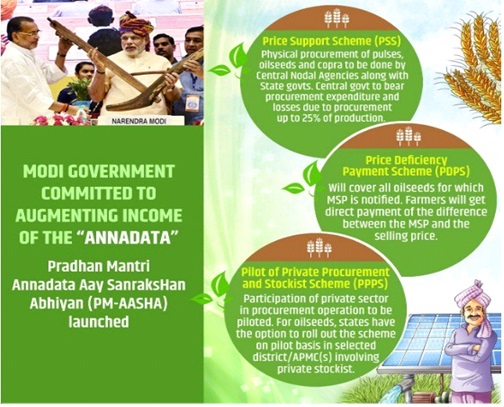(HOT) UPSC Current Affairs 2025 PDF
NEW! The Gist (NOV-2025) | E-BOOKS
Pradhan Mantri Annadata Aay Sanrakshan Abhiyan (PM-AASHA) : Important Topics for UPSC Exams

Pradhan Mantri Annadata Aay Sanrakshan Abhiyan (PM-AASHA)
The Union Cabinet recently approved an umbrella scheme for farmers called PM-AASHA. The scheme caters to the farmers and is aimed at ensuring remunerative prices to the farmers for their produce as announced in the union budget for 2018. The scheme seeks to ensure that poor farmers growing pulses and oilseeds benefit from higher Minimum Support Price (MSP) announced by the government.
Government has already increased the MSP of Kharif crop by following the principle of 1.5 times the cost of production. It is expected that the increase in MSP will be translated to farmer's income by way of robust procurement mechanism in coordination with the state government.
Components of PM- AASHA :

PM-AASHA is a mix of sub-schemes and state can choose out of them.
1. Price Support Scheme-- This scheme will kick in when prices of pulses, oilseeds and copra fall below MSP, with center bearing the procurement expenditure and losses up to 25% of the production. Physical procurement will be done by central nodal agencies with proactive role of state governments. It is also decided that in addition to NAFED, FCI will take PSS operations in states/ districts.
2. Price Deficiency Payment Scheme (PDPS)-- The scheme is on line of MP government's Bhavantar Bhugtan yojana, but will protect oilseeds farmers only. Under PDPD, the govt will pay to growers the difference between the MSP and monthly average price of oilseeds quoted in wholesale market. The price difference will be made to pre-registered farmers in their bank accounts selling the produce in the notified market yard through a transparent auction process. The government will not undertake physical procurement of the crop under the scheme.
3. Pilot of Private Procurement and Stockist Scheme (PPPS)-- Besides above schemes, the states are given an option to rope in private players for oilseeds procurement on a pilot basis so that the ambit of private participation could be increased. The pilot districts/ selected APMCs of districts will cover one or more crops of oilseeds for which MSP is notified where it will substitute PSS / PDPS.
The selected private agency shall procure the commodity at MSP in notified market during the notified period from the registered farmers in consonance with the PPPS guidelines, whenever the prices in the market fall below the notified MSP and whenever authorized by the state/UT government to enter the market.
The center has made the provision of Rs. 16,550 Crore as a bank guarantee for central agencies to directly procure from farmers under PSS, while the budgetary allocation for PM-AASHA has been raised to Rs. 15,053 Crore.
Why PM-AASHA? :
- Over the past two years, famers bear huge losses due to increased production of oilseeds and pulses. High production leads to fall in the wholesale prices of these commodities.
- It is evident that increased MSP in past is not sufficient and limited modus operandi for the distribution of the MSP benefits is not good for all the states/UTs.
- The government, therefore, realize that it is very important that if the price of the agriculture produce market is less than the MSP, both central and states should purchase either at MSP or work in manner to provide MSP for farmers through some other mechanisms.
Way Forward :
The dream of doubling the farmer's income by 2022 can only be realized only if farmers get fair prices of their produce. The emphasis should be on enhancing productivity, reducing cost of cultivation and strengthening post harvesting management, including market structure.
There are high chances that there may be a direct question in GS Mains paper 2 or 3. The format may be
Q. The government efforts are to increase not only the MSP, but also to ensure that farmers get the benefits of it. The PM-AASHA is an innovative step in this direction. Examine.
Hint-- Try to take important points from article. Start with the issue of mismanagement in central-state levels. Then show how PM-AASHA can help in tacking the issue. Conclude with futuristic approach like how the scheme would help in doubling farmer's income by 2022.

